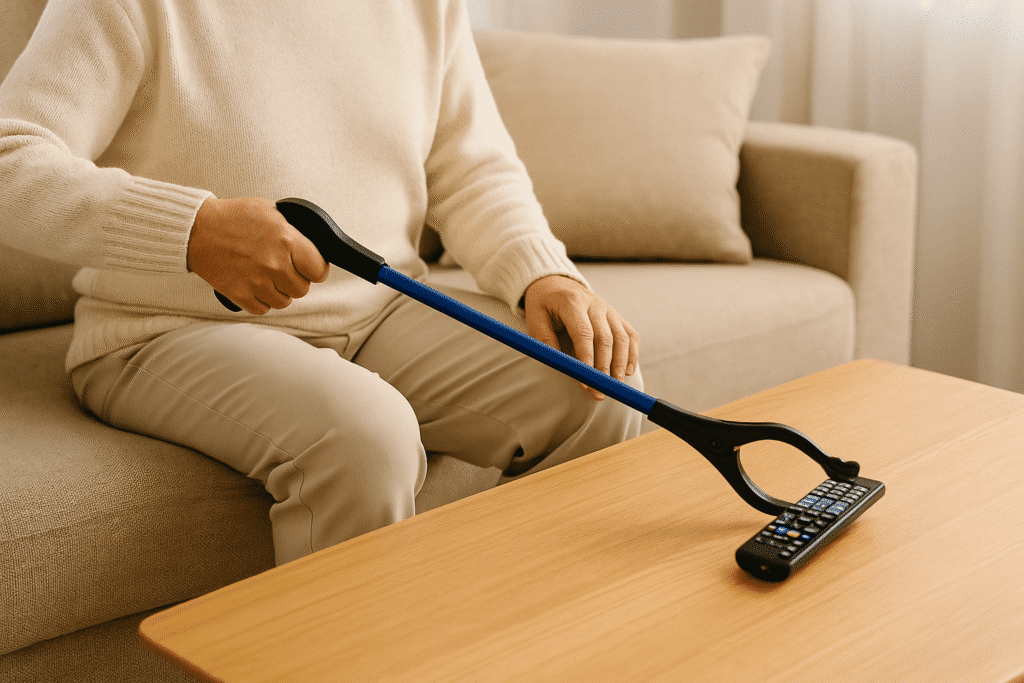If you have arthritis, opening a simple jar can feel like trying to twist a stuck bolt. Pain, stiffness, and weak grip strength can make even small kitchen tasks difficult.
The good news is there are many simple tricks and arthritis-friendly tools that make jar opening safer and easier for your hands.
Let’s look at how to open jars with arthritis without strain or frustration.
Key Summary:
To open jars with arthritis, improve your grip and reduce wrist strain. Use rubber gloves, gripper pads, or a damp towel for traction, and loosen tight lids by tapping or running them under warm water. For tougher jars, try electric or mounted openers that twist for you. Choose smaller jars with easy-grip lids and keep your hands flexible with light stretching and simple hand exercises.
Why Jar Lids Are So Hard on Arthritic Hands
Opening a jar is difficult with arthritis because it requires both grip strength and wrist rotation, two motions that arthritis makes painful and limited.
The tight seal of most jar lids needs more twisting power than inflamed joints can comfortably handle.
Arthritis affects the small joints in your fingers, thumbs, and wrists, causing swelling, stiffness, and pain. When you twist a lid, those same joints must work together to create torque.
If even one joint is sore or weak, it becomes hard to apply enough pressure to break the seal.
It is not just about strength. For many older adults, grip control and coordination also change over time. That is why techniques like improving traction, using leverage, or breaking the seal first can make a big difference.
Small adjustments such as using gloves or a grippy pad can protect your joints while restoring independence in the kitchen.
How to Open Jars with Arthritis: 25 Easy Tips
These practical tips come from occupational therapists, senior care experts, and real experiences helping older adults live more comfortably. Start with whichever method feels easiest for you, and combine a few if needed.
1. Wear Rubber Gloves for Instant Grip
Rubber dishwashing or gardening gloves add friction and protect your joints from direct pressure. They create a firm, slip-free grip even on smooth glass lids.
Choose gloves with textured palms for the best hold. This method works well if your hands are sore or swollen because the glove absorbs some of the force needed to twist.
2. Wrap a Rubber Band Around the Lid
Keep a few wide rubber bands in your kitchen drawer. Slide one around the lid before twisting. The rubber helps your fingers grip the lid without slipping, so you use less strength.
This is one of the easiest no-tool tricks for opening jars when your hands hurt.
3. Use a Silicone or Dycem Gripper Pad
Silicone pads or Dycem material are staples in therapy clinics. They grip tightly without needing pressure from your hand.
Place one over the lid or under the jar to keep it steady while you twist. They are inexpensive, washable, and especially useful if you have arthritis in both hands or limited wrist movement.
4. Hold the Jar Close to Your Body
Instead of twisting with your arms extended, bring the jar close to your chest or stomach. This lets you use your stronger arm and shoulder muscles to help, instead of relying only on your fingers and wrists.
You will feel steadier, and you will not strain small joints that are already sensitive.
5. Stabilize the Jar on a Non-Slip Surface
A jar that moves around can make the task twice as hard. Set the jar on a rubber mat, a silicone baking sheet, or a damp washcloth to stop it from sliding.
Once it stays still, you can twist the lid using a smoother, more controlled motion. Some people even use a drawer liner or a piece of non-skid shelf material for this purpose.
6. Use a Damp Towel for Friction
If you do not have a special gripper pad, grab a dish towel and make it slightly damp. The light moisture helps the fabric stick to the lid, giving your fingers more traction.
Wrap the towel around the lid, hold the jar firmly with your other hand, and twist gently. It is a quick, easy fix that saves strain on tender joints.
7. Tap Around the Lid Edge
Sometimes the seal on a new jar is simply too tight. Lightly tap around the rim of the lid using the handle of a butter knife, a wooden spoon, or the back of a spoon.
The tapping loosens the vacuum seal inside the jar. You do not need to hit hard. A few gentle taps are usually enough to let air in and make the lid twist more easily.
8. Run the Lid Under Warm Water
Warm water can help when a metal lid feels stuck. Hold the jar upside down and run warm water over the lid for about 30 seconds. The metal expands slightly faster than the glass, breaking the tight seal naturally.
This trick is especially useful for sticky jars such as jam, honey, or sauce that may have residue around the rim. Just be careful not to overheat the jar or get water inside.
9. Whack the Bottom of the Jar
Before twisting, give the bottom of the jar a firm but controlled whack with the palm of your hand. This helps push air to the top and can loosen the vacuum seal holding the lid in place.
You only need a quick, light hit, not a hard slam. If your hands are very sore, you can tap the base against a folded towel on the counter instead.
10. Use a Butter Knife to Release Air
If the lid still will not move, try using the tip of a butter knife to gently lift the edge of the lid. Place the tip under the rim and tilt it slightly until you hear a small pop.
That sound means air has entered the jar, breaking the seal. Once the seal is gone, the lid should twist off easily. Be gentle so you do not bend the lid or cut yourself.
11. Try a Contoured Manual Jar Opener
Manual jar openers with contoured handles give you better leverage. They have small metal teeth that grip the lid tightly while the long handle multiplies your strength.
You only need a slight twist to open even tough jars. Look for openers with wide, soft handles that are easy to hold if you have hand pain or limited motion.
12. Install an Under-Cabinet Jar Opener
An under-cabinet jar opener mounts permanently beneath your kitchen counter. You slide the jar lid into the V-shaped teeth, hold the jar with one hand, and twist.
The opener grips the lid firmly for you, so you do not have to use much force. It is an excellent option for people with arthritis in both hands or reduced hand coordination.
13. Keep a Pocket Multi-Opener Tool
A pocket-sized multi-opener can open jars, bottles, and pull tabs without stressing your joints. These small devices often have rubber grips and several shapes for different lids.
Keep one near the kitchen sink or carry one in your bag if you often eat away from home. It is a simple and affordable gadget that saves your hands a lot of work.
14. Use an Electric Jar Opener
Electric or battery-powered jar openers do all the twisting for you. Place the opener on top of the jar, press a button, and the machine automatically grips and removes the lid.
These are perfect if you have moderate to severe arthritis or very limited grip strength. They work especially well for stubborn metal lids that are difficult to twist manually.
15. Try a Jar Key for Sealed Lids
A jar key is a small lever tool designed specifically to break vacuum seals. You hook it under the edge of the lid and lift gently until the seal pops.
This removes the resistance so you can open the jar with almost no twisting at all.
Jar keys are ideal if you have sensitive wrist joints or trouble with twisting motions.
16. Use a Spoon Handle for Leverage
If you do not have a jar key, you can do something similar with a sturdy spoon. Slide the handle under the lid’s rim and gently lift until you hear a pop.
That bit of leverage allows air inside and loosens the lid. Be sure to work slowly and evenly around the edge so you do not chip the glass or bend the lid too much.
17. Heat Sticky Lids Safely
Some jars become stuck because of dried or sugary residue. To loosen them, fill a bowl or pie plate with hot (not boiling) water and place the jar upside down so the lid is submerged for 30 seconds.
The heat softens sticky residue and expands the metal lid slightly. Dry it off before twisting to avoid slipping. This method works well for jams, syrups, and sauces.
18. Use an Oven Mitt or Silicone Pot Holder
When you do not have a gripper pad nearby, slip on a thick oven mitt or use a silicone pot holder. The textured surface provides traction, while the padding protects sore joints from direct pressure.
This simple switch can make jar opening much more comfortable, especially if your fingers ache from arthritis.
19. Buy Smaller or Lightweight Jars
Large jars can be heavy and hard to manage for anyone with limited strength. When shopping, choose smaller containers that are easier to hold and control.
Many foods now come in single-serving or half-size jars that offer the same quality with less strain. Smaller jars are not only easier to open but also safer to handle and store.
20. Choose Lids with Ridges or Pop-Tops
Not all packaging is created equal. Some brands design jars with wide, ridged, or pop-up lids that are easier to grip.
When possible, choose products with textured plastic lids instead of smooth metal ones.
They are lighter, safer for older hands, and often require less twisting force. Paying attention to packaging can save you effort every time you cook.
21. Use Your Elbow or Hip for Support
You can use your body to help open jars instead of relying only on your hands. Hold the jar firmly against your hip or the edge of a counter, then twist the lid with both hands.
This gives you more stability and lets your larger arm and shoulder muscles assist. It is a simple way to reduce hand strain during a tough task.
22. Strengthen Hands with a Soft Ball
A little daily hand exercise can make a big difference. Use a soft stress ball, therapy putty, or sponge ball to gently squeeze for a few minutes at a time.
This helps improve grip strength and flexibility over time. Start slow and avoid overexertion.
Consistent light exercise supports your joints and makes everyday tasks, like opening jars, much easier.
23. Stretch Fingers and Wrists Each Morning
Before using your hands for tasks like cooking, take a few moments to stretch. Slowly make a fist, then open your hand wide, spreading your fingers apart.
Roll your wrists in gentle circles to loosen them up. These small stretches improve circulation, reduce stiffness, and help your joints stay flexible throughout the day.
24. Avoid Opening Jars During Pain Flares
If your hands are swollen or painful, wait until your joints feel more relaxed before tackling tight lids. Forcing a jar open when your pain is high can cause inflammation and soreness later.
It is always okay to ask for help or use an electric opener on bad days. Protecting your joints today keeps them stronger for the future.
25. Ask an Occupational Therapist for Custom Solutions
An occupational therapist (OT) can teach you joint-safe ways to perform daily activities and recommend adaptive tools designed for arthritis.
They can also evaluate your kitchen setup and suggest modifications to make it easier and safer to cook independently.
Personalized advice from an OT can greatly reduce hand strain and improve your confidence at home.
Final Words
Living with arthritis can make simple everyday tasks, like opening a jar, feel frustrating. But with a few smart techniques and the right tools, you can make life in the kitchen much easier.
From improving your grip with rubber gloves or a damp towel to using electric or mounted openers, there is always a way to open jars safely without hurting your hands.
Remember, the goal is not to rely on strength but to work smarter. Stabilizing the jar, breaking the seal first, or choosing smaller containers can all reduce pressure on your joints.
Over time, small changes like hand exercises and stretching will also help improve your flexibility and control.
Most importantly, do not push through pain. Use adaptive tools, pace yourself, and seek advice from an occupational therapist if certain tasks remain difficult.
With patience and the right support, you can protect your joints and stay confident and independent in your kitchen.
Lauren brings 8+ years of writing experience focused on accessibility, home organization, and senior living. Her practical guides are shaped by conversations with seniors and caregivers, helping readers simplify daily tasks with clarity and confidence.









